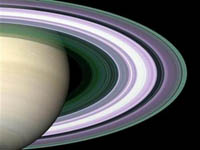Researchers Discover the Seventh Ring of Saturn
The Spitzer Space Telescope has discovered the biggest but never-before-seen ring around the planet Saturn, acording to NASA's Jet Propulsion Laboratory.

The thin array of ice and dust particles lies at the far reaches of the Saturnian system and its orbit is tilted 27 degrees from the planet's main ring plane, the laboratory said.
JPL spokeswoman Whitney Clavin said the ring is very diffuse and doesn't reflect much visible light but the infrared Spitzer telescope was able to detect it.
Although the ring dust is very cold — minus 316 degrees Fahrenheit — it shines with thermal radiation.
No one had looked at its location with an infrared instrument until now, Clavin said.
The bulk of the ring material starts about 3.7 million miles from the planet and extends outward about another 7.4 million miles.
The newly found ring is so huge it would take 1 billion Earths to fill it, JPL said.
Before the discovery Saturn was known to have seven main rings named A through E and several faint unnamed rings.
Saturn's moon Phoebe orbits within the ring and is believed to be the source of the material.
The ring also may answer the riddle of another moon, Iapetus, which has a bright side and a very dark side.
The ring circles in the same direction as Phoebe, while Iapetus, the other rings and most of Saturn's other moons go the opposite way. Scientists think material from the outer ring moves inward and slams into Iapetus.
The Spitzer mission, launched in 2003, is managed by JPL in Pasadena. Spitzer is 66 million miles from Earth in orbit around the sun. Reported by the Associated Press.
Subscribe to Pravda.Ru Telegram channel, Facebook, RSS!





